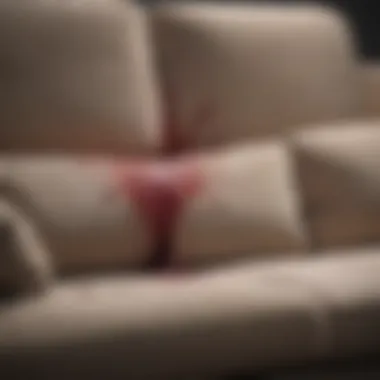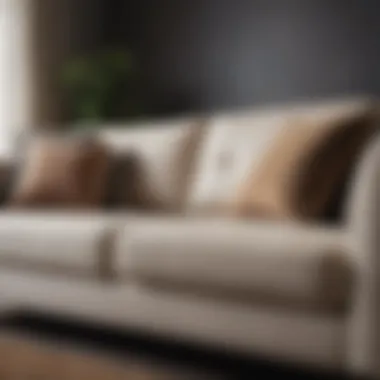Expert Techniques to Remove Stains from Fabric Couches


Intro
Stains on fabric couches can be a nuisance. They not only affect the appearance of your furniture but can also lead to permanent damage if not addressed promptly. Knowing how to remove these stains effectively can make a significant difference in maintaining the aesthetic and functional value of upholstery. This guide provides detailed methodologies for handling various stains, including food, beverages, and ink, with a focus on practical, non-toxic solutions.
The significance of early intervention cannot be overstated. Acting quickly can prevent a stain from setting in, making cleaning simpler and more effective. In addition to stain removal techniques, the guide offers preventive measures to protect your fabric couch from future mishaps. Whether you are a homeowner looking to preserve your furniture or an interior design enthusiast intrigued by cleaning aesthetics, understanding the right approaches to maintain fabric integrity is crucial. This knowledge serves as an essential resource for keeping your fabric couches looking their best.
Featured Homes
Although the primary focus here is on cleaning, the context in which couches are placed can also impact their upkeep. A well-designed home helps to prevent stains before they happen.
Architectural Highlights
Homes with open layouts often see higher traffic in sitting areas, leading to more potential for spills. The choice of materials and finishes in these spaces influences how stains can be managed. For example, lighter fabrics may show stains more readily, while darker options can often mask minor blemishes more effectively. Taking care to select appropriate fabric choices that match your lifestyle is an important strategic decision.
Interior Design Themes
Various design themes promote both aesthetics and functionality. Minimalist designs can reduce clutter, which often leads to fewer food or drink incidents. On the other hand, cozy, inviting spaces may encourage dining on the couch or relaxed lounging, increasing the risk of stains. Therefore, it is wise to choose fabrics that not only enhance the visual appeal of the room but are also durable and easy to clean.
Incorporating practical elements, such as washable cushion covers or stain-resistant fabrics, can be beneficial in maintaining the integrity of your couch. This knowledge provides a framework for thoughtfully designing a space while being aware of the potential pitfalls associated with fabric furniture. Understanding the intersection of design and functionality equips homeowners with the tools necessary to preserve both beauty and endurance in their upholstery.
Understanding Fabric Couches
Understanding fabric couches is essential for effective maintenance and stain removal. Fabric couches come in a variety of materials, each with unique characteristics that influence cleaning methods. Recognizing these characteristics allows homeowners to select appropriate cleaning techniques and avoid potential damage. Knowing the composition of upholstery also informs the way stains should be tackled, distinguishing between challenging and manageable marks.
Types of Fabric Materials
Fabric couches can consist of various types of materials. These include:
- Cotton: Known for its softness and breathability. Cotton can absorb stains more easily, requiring prompt cleaning to prevent lasting marks.
- Polyester: This synthetic fabric is durable and stain-resistant. It is often easier to clean than natural fabrics, but not all polyester blends handle stains equally.
- Microfiber: This tightly woven fabric resists stains and is simple to maintain. Microfiber is excellent at repelling spills, making it an ideal choice for households with children or pets.
- Linen: A luxurious option, linen lends an elegant touch to furniture. However, it is more prone to wrinkling and stains may set quickly if not addressed.
Each of these fabrics brings benefits and considerations when dealing with stains. Selecting the right cleaning method depends on understanding the specific fabric type.
Common Stain Problems on Fabric Couches
Stains on fabric couches can stem from a variety of sources, leading to different cleaning challenges:
- Food Stains: Items like sauces, cheese, or crumbs can lead to unsightly spots. Food stains often require immediate action to prevent deeper absorption into the fabric.
- Beverage Spills: Drinks like coffee, tea, and wine can cause discoloration. Quick attention is crucial in this case, as these liquids can leave lasting marks.
- Ink and Dye Stains: Whether from pens or transferred dye from clothing, ink stains are multifaceted and can be especially difficult to remove.
- Grease and Oil Stains: These come from snacks or oil-based products. They can penetrate fabrics quickly and require specialized cleaning solutions to address effectively.
- Pet-related Stains: Accidents from pets present unique challenges. Urine, vomit, or hair can lead to both stains and odors that necessitate thorough cleaning.
Addressing specific stains promptly is vital to preserve the couch's appearance and integrity. Each type of stain requires different approaches and solutions.
Preparing to Clean
Before tackling stains on fabric couches, it is essential to prepare adequately. This preparation not only increases the chances of effective stain removal but also protects the integrity of the fabric. Investing time in this initial step can save you from potential damage and make the cleaning process much smoother.
Assessing the Stain Type
Understanding the nature of the stain is crucial. Knowing if it is oil-based, water-based, or acidic will dictate the cleaning agent you should use. For instance, grease stains from food will require a different approach than spilled beverages. Assessing the stain type can be achieved through a careful examination of its color, texture, and the material causing it. This systematic assessment helps in determining the most effective cleaning method. It is ideal to act quickly; newer stains are generally easier to remove than older ones.


Reading Care Labels
Every fabric couch comes with a care label that provides essential information regarding cleaning. This label indicates the recommended cleaning methods and any restrictions. For example, some fabrics may be water-safe, while others require solvent-based cleaners. Familiarity with these instructions is vital; ignoring them may lead to discoloration or damage. Additionally, care labels may specify how to address various types of stains, providing you with tailored guidance for your cleaning efforts.
Gathering Necessary Supplies
Once you are informed about the stain type and have understood the care requirements, the next step is to gather your cleaning supplies. Having the right tools and cleaners on hand is key to an efficient cleaning process. Essential items include:
- Soft cloths or sponges for applying cleaning solutions.
- Mild detergent for general cleaning.
- White vinegar or baking soda as natural agents.
- Specialty cleaners if required (like those for ink stains).
Collecting all items in advance ensures that you do not disrupt the cleaning process by searching for supplies mid-way. This organized approach makes the process much more efficient.
General Cleaning Techniques
General cleaning techniques are vital when addressing stains on fabric couches. These methods not only prepare the fabric for deeper cleaning but also help to maintain its integrity over time. Regular use of proper cleaning techniques can prevent the accumulation of dirt and stains, thus extending the life of your sofa. Understanding how to effectively clean your couch will enhance its appearance and durability.
Using Water and Mild Detergent
Water is often the most accessible and safe option for initial stain removal. Using a mixture of water and a mild detergent can be effective for general dirt and light stains. It's important to choose a detergent that is free from harsh chemicals that might damage delicate fabrics.
To apply this technique:
- Start by mixing a small amount of mild detergent with lukewarm water.
- Dampen a clean cloth in the solution.
- Blot the stained area gently, avoiding excessive rubbing which can lead to fabric damage.
- Rinse the cloth with clean water and blot the area again to remove any detergent residue.
This method is suitable for various fabric types, providing a gentle yet efficient way to clean your couch.
Spot Cleaning Methods
Spot cleaning is essential for treating specific stains swiftly before they set. It focuses on removing the stain without affecting the surrounding fabric. Each stain type might require a different spot cleaning approach. The key to successful spot cleaning is to act quickly and select the right cleaning product.
Some techniques include:
- For liquid stains, use a clean cloth to blot the area, soaking up as much liquid as possible before applying a cleaning solution.
- For solid stains, scrape off excess residue gently with a dull knife, taking care not to damage the fabric. Follow up with a cleaning solution suitable for the stain type.
- Always test any cleaning solution on a hidden area first to ensure there are no adverse effects.
Regular spot cleaning not only keeps fabric couches looking their best but also prevents long-term damage and discoloration.
Specific Stain Removal Techniques
Removing stains from fabric couches requires an understanding of the nature of the stains. The right technique can significantly enhance the outcome of your cleaning efforts. If you address stains promptly and effectively, your upholstery can maintain its aesthetic integrity and prolong its lifespan. Each type of stain has unique characteristics that may necessitate a particular cleaning method. Knowing these specifics allows for an efficient and thorough cleaning process. Below are common types of stains and the effective techniques to address them.
Food Stains
Food stains can be difficult to treat as they come in various types and ingredients. Common culprits include sauces, oils, and even crumbs. To start, remove any solid food particles carefully with a butter knife or spoon, being cautious to not push the stain deeper.
Next, create a cleaning solution using a mild detergent and water. It's best to test this solution on a hidden area of the fabric first to avoid discoloration. Apply the mixture using a clean cloth, working from the outside of the stain towards the center. This helps prevent spreading the stain further. Blot gently rather than rubbing to not damage the fabric. Rinse with a clean damp cloth and allow to air dry.
Beverage Spills


Beverage spills are among the most common stains found on fabric couches. Liquid stains from drinks like coffee, tea, and wine can quickly seep into the fibers.
To treat these stains, first blot the area with a clean, dry cloth to absorb excess liquid. Then, use a mixture of vinegar, water, and a small amount of dish soap to target the stain. Apply this solution with a cloth, working gently to lift the stain. Once treated, rinse the area with clean water and blot to remove any excess moisture. It is critical to act fast since letting these stains sit can make removal significantly harder.
Ink and Dye Stains
Ink and dye represent a significant challenge when it comes to fabric maintenance. Such stains often arise from broken pens or accidentally spilling dye.
For ink stains, the first step is to dab the area with rubbing alcohol on a cotton ball. This method effectively breaks down the ink particles. It is important to test this method on a less visible area beforehand. After application, blot the ink stain using a fresh cloth until no more ink lifts away. For dye stains, using products specifically for color transfer may be necessary. Always follow the manufacturer’s instructions carefully to avoid damage.
Grease and Oil Stains
Grease and oil stains can leave unsightly marks on your couch. These stains often come from greasy foods or oils used in cooking. As they are oily in nature, water alone may not suffice in removal.
To tackle these types of stains, start by sprinkling a generous amount of cornstarch or baking soda directly onto the stain. These powders help absorb the oil. Let it sit for about 15 minutes, then vacuum up the remaining powder. After the powder has been removed, apply a mild detergent mixed with water to the stained area and blot it gently. Rinse with a damp cloth and allow it to air dry.
Pet-related Stains
Pet stains can include urine, feces, or vomit, each presenting unique challenges.
For urine stains, begin by soaking up as much liquid as possible with paper towels. Then, use a mixture of vinegar and water to neutralize the odor. Apply this to the stain, and always follow up with a clean damp cloth. For pet hair, a lint roller or damp rubber gloves can effectively gather fur from the fabric. Remember to work quickly with all pet stains as delaying can lead to stronger odors and more difficult removal.
It's crucial to understand that different stain types require tailored approaches, and using the right method can result in successful and effective cleaning.
Alternative Cleaning Solutions
Alternative cleaning solutions for fabric couches provide a crucial complement to traditional methods. These techniques often utilize common household items or specialized products, offering various advantages. The incentive to explore these options includes safety for sensitive materials, effectiveness against tough stains, and potential cost savings. Both natural agents and commercial products have their unique benefits, which cater to different cleaning preferences and requirements.
Natural Cleaning Agents
Natural cleaning agents offer a myriad of benefits for those seeking effective yet eco-friendly solutions. Items such as vinegar, baking soda, and lemon juice serve as versatile tools against stains. These agents are often non-toxic and safe for pets and children, making them an ideal choice for families.
- Vinegar is a powerful disinfectant and can effectively break down many types of stains. Its acidic nature cuts through grease and neutralizes odors, which can greatly benefit fabric couches that tend to absorb smells.
- Baking soda is exceptional for absorbing moisture and odors. When mixed with water, it forms a paste that can be applied directly to stains, allowing it to sit for a while before being removed.
- Lemon juice acts as a natural bleaching agent. While it is not suitable for all fabric colors, it can be particularly effective on light-colored fabrics and can help lift stains when combined with salt for a gentle abrasive action.
Using these natural solutions not only promotes a healthier environment but often reduces the financial burden of purchasing specialized cleaning products.
Commercial Cleaning Products
Commercial cleaning products provide specialized solutions tailored explicitly for various fabric types and stains. These products are formulated with specific chemical properties designed to tackle stubborn stains more effectively than household substitutes.
When selecting a commercial cleaner, several considerations are essential:
- Type of Stain: Different products target specific stains such as ink, grease, or wine, so it is important to choose a product that meets the needs of your situation.
- Fabric Compatibility: It is critical to ensure that the product is compatible with your fabric’s material. Always refer to the care label before application.
- Safety and Ingredients: Consider products that are environmentally friendly and safe for home use. Some brands prioritize safer cleaning ingredients, minimizing the health risks associated with harsher chemicals.
Popular commercial products often include those from Bissell or Folex, which can effectively remove various stains while being gentle on fabric. When used correctly, these commercial cleaners can significantly decrease the effort and time required for stain removal.
Important Note: Always test any cleaner, whether natural or commercial, on a hidden section of the couch first to prevent damage or discoloration.


Preventive Care for Fabric Couches
Preventive care for fabric couches is key to maintaining both appearance and longevity. This segment outlines how simple practices can safeguard your upholstery from stains, while also enhancing its general durability. Addressing potential issues before they arise is considerably easier than dealing with the consequences after stains have set in. This proactive approach will not only extend the life of your furniture but also keep it looking fresh and inviting.
Regular Maintenance Practices
Establishing a routine for maintaining your fabric couch can make a significant difference over time. Here are several practical steps:
- Vacuum Regularly: Use a vacuum with an upholstery attachment at least once a week. This will help remove dust and debris that might settle into the fabric fibers.
- Address Spills Promptly: If something spills on the couch, act fast. Blot the area with a clean, dry cloth rather than rubbing. Rubbing can push the stain further into the fabric.
- Rotate Cushions: If your couch has removable cushions, rotate them regularly. This allows even wear and helps maintain their shape.
- Prevent Direct Sunlight: Sunlight can fade colors over time. If possible, position the couch away from direct light, or use curtains to limit exposure.
Implementing these practices creates a sustainable care regime that benefits both the furniture and the homeowner.
Using Fabric Protectors
Fabric protectors are a valuable tool in the fight against stains and abrasions. Applying a protectant can provide an invisible barrier against spills, dirt, and even UV rays that cause fading. Here are some points to consider:
- Select the Right Protector: Choose a product specifically designed for your type of fabric. Not all protectors are suitable for all materials, and using the wrong one can cause damage.
- Follow Instructions Carefully: Different products come with varying application methods. Some may require professional use, while others are simple to apply at home. Read the labels for detailed instruction.
- Reapply Periodically: Fabric protectors wear off over time. A rule of thumb is to reapply every 6 to 12 months, depending on use and exposure.
"Preventive measures are not just about keeping things clean; they contribute to the overall integrity and aesthetics of your upholstery."
Using fabric protectors is an investment that pays off in long-term savings on cleaning and repairs. Overall, both regular maintenance and the use of protectors can effectively prolong the life of fabric couches, keeping them in optimal condition.
When to Seek Professional Help
Recognizing when to enlist professional help for fabric couch stains is crucial for maintaining your upholstery's longevity and aesthetics. Not every stain can be tackled with DIY methods, and in some cases, the risk of further damage due to improper cleaning techniques may outweigh the benefits. Understanding this topic can save you time, money, and frustration.
Identifying Severe Stains
Severe stains often present unique challenges that require the expertise of professionals. Here are some indicators that a stain is beyond casual cleaning:
- Persistent discoloration: If the stain does not respond to home cleaning attempts, it may be time to call in experts.
- Staining from harsh substances: Chemicals like bleach, permanent markers, or heavy dyes often penetrate fabric and require specialized treatment.
- Large areas affected: When a significant portion of the fabric is stained, DIY solutions may not effectively restore the couch's appearance.
- Complicated fabrics: Some high-end fabrics like silk or velvet necessitate specialized cleaning methods that professionals are trained to apply.
A noticeable sign can be the fabric's texture, too; if it feels rough or stiff after cleaning attempts, it may have been damaged beyond simple fixes.
Understanding Professional Cleaning Options
When considering professional cleaning for your fabric couch, several options are available:
- Steam cleaning: This method uses high-temperature steam to lift dirt and grime from the fabric. It is effective with many stains and sanitizes the fabric in the process.
- Dry cleaning: Some professionals offer a solvent-based cleaning that does not require water, which is ideal for sensitive fabrics that may be damaged by moisture.
- Spot treatment: Experts can apply specialized chemicals designed to treat specific stains while avoiding damage to the surrounding fabric.
- Reupholstering: In extreme cases, if the fabric is too stained or damaged, reupholstering the entire couch may be a worthwhile investment.
"Professional cleaning options not only restore the appearance of your fabric couch but can also enhance its lifespan, protecting your investment for years to come."
Before deciding on a cleaning service, it’s advisable to check credentials and read reviews. Many companies offer consultations that help assess the condition of your upholstery. Investing in professional cleaning when necessary contributes to preserving not just the look but also the overall value of your furniture.
Ending
In the realm of fabric care, understanding the specific needs of different fabric types is crucial. Each stain presents unique challenges, thus recognizing the appropriate cleaning strategies can prevent permanent damage. A well-informed homeowner can navigate the complexities of upholstery maintenance, minimizing the risk of recurring stains.
Final Thoughts on Fabric Care
Emphasizing a balanced approach, the final thoughts highlight several key elements:
- Regular Maintenance: Encourage the practice of routine cleaning to prevent buildup of dirt and grime.
- Appropriate Products: Use cleaning agents suitable for specific fabric types, ensuring that the cleaning process is safe and effective.
- Stain Prevention: Consider implementing protective measures, such as fabric protectors, addressing stains before they happen.
- Professional Help: Recognizing when to seek assistance from professionals ensures treatment is conducted with precision.
Overall, a thoughtful approach to fabric care promotes a longer lifespan for furniture, preserving its beauty and functionality. Investing time and effort into maintaining fabric couches not only enhances the living environment but also adds to the overall quality of life. The information discussed in this article offers valuable guidance, helping homeowners make informed decisions about their upholstery care.







